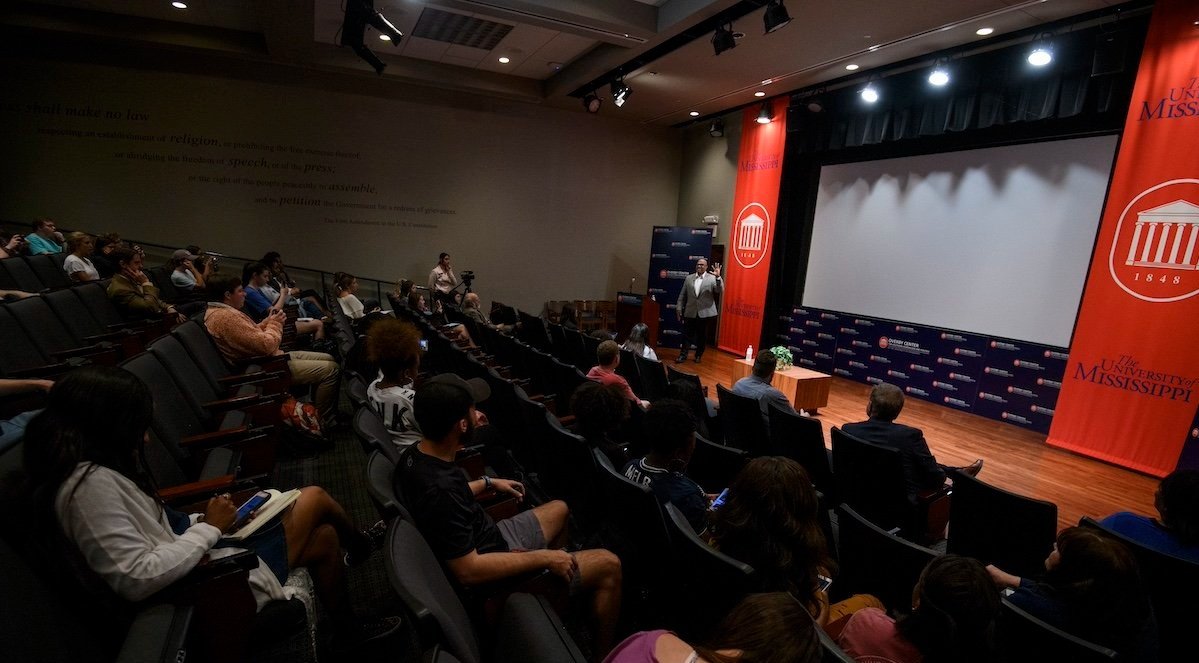Today's front pages from around the South.
Front pages powered by the Freedom Forum
A new documentary film on Soggy Sweat’s iconic Whiskey Speech will be presented at a program in October by the Overby Center for Southern Journalism and Politics. When Prohibition was still in effect in Mississippi and the issue of liquor a major point of political and social discussion, Judge Noah S. “Soggy” Sweat first delivered the speech at the King Edward Hotel in Jackson, Miss., in 1952.
Southern comedian Jeff Foxworthy has made the meme “you might be a redneck if…” famous. He tells Terry Mattingly of the Overby Center that since “we agree on about 85% of stuff,” he likes to stay in his own lane in his comedy routines.
The first 100 days of the Trump administration and interviewing notable women such as Barbara Walters were discussed in a program at the Overby Center for Southern Journalism and Politics. Susan Page, Washington Bureau chief for USA TODAY and a veteran reporter and observer of American politics, discussed her journalistic career.
A new documentary film on Soggy Sweat’s iconic Whiskey Speech will be presented at a program in October by the Overby Center for Southern Journalism and Politics. When Prohibition was still in effect in Mississippi and the issue of liquor a major point of political and social discussion, Judge Noah S. “Soggy” Sweat first delivered the speech at the King Edward Hotel in Jackson, Miss., in 1952.
Southern comedian Jeff Foxworthy has made the meme “you might be a redneck if…” famous. He tells Terry Mattingly of the Overby Center that since “we agree on about 85% of stuff,” he likes to stay in his own lane in his comedy routines.
The first 100 days of the Trump administration and interviewing notable women such as Barbara Walters were discussed in a program at the Overby Center for Southern Journalism and Politics. Susan Page, Washington Bureau chief for USA TODAY and a veteran reporter and observer of American politics, discussed her journalistic career.
There’s a story behind how Baylor University in Waco, Texas, became the center of a significant project to preserve and store Black gospel music. Robert Darden, a member of the Overby Center panel of experts and professor emeritus at Baylor, tells the story.
News organizations have been trumpeting partnerships with AI firms, but they should be entering such arrangements with caution. Jared Schroeder of the University of Missouri and a member of the Overby Center panel of experts writes that such partnerships could damage journalism in the long run.
In an exclusive Q&A with the Overby Center for Southern Journalism and Politics, Paul Keane shares his insights on the future of journalism, public relations, and the emergence of artificial intelligence.
Southern Views & Current Topics
Explore insights and analysis from our Overby Center experts

About the Overby Center
The Overby Center for Southern Journalism & Politics explores the current intersection of media and politics in the American South and supports the principles of the First Amendment.
An independent center based on the University of Mississippi campus, it is an affiliate of the Freedom Forum in Washington, D.C.
Overby Center Events
“USA TODAY Washington Bureau chief Susan Page says Trump has instituted broad change in first 100 days”
Tuesday, April 29, 2025 — The first 100 days of the Trump administration and interviewing notable women such as Barbara Walters were discussed in a program at the Overby Center for Southern Journalism and Politics. Susan Page, Washington Bureau chief for USA TODAY and a veteran reporter and observer of American politics, discussed her journalistic career.
UP NEXT —
Bob Dylan’s civil rights work and Mississippi connections to be focus of Overby Center program
Wednesday, October 8, 2025 — The music and early civil rights work of legendary singer-songwriter Bob Dylan will be the focus of a fall program at the Overby Center for Southern Journalism and Politics. “Songs of Freedom: Bob Dylan’s Mississippi,” will be presented Oct. 8 at 5:30 p.m. in the Overby Center Auditorium on the Ole Miss campus.
UP NEXT —
“Overby Center to feature documentary on Soggy Sweat’s Whiskey Speech in October program”
Wednesday, October 29, 2025 — A new documentary film on Soggy Sweat’s iconic Whiskey Speech will be presented at a program in October by the Overby Center for Southern Journalism and Politics. When Prohibition was still in effect in Mississippi and the issue of liquor a major point of political and social discussion, Judge Noah S. “Soggy” Sweat first delivered the speech at the King Edward Hotel in Jackson, Miss., in 1952.





















